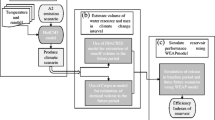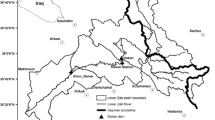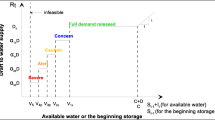Abstract
Reservoirs play a fundamental role in enhancing sustainable development and economic circumstances, especially in areas with limited water resources. Recently, experts in water resources management have been faced with global warming and climate change as two critical issues that are causing serious problems in water resources. Accordingly, the current study attempts to evaluate the future climate change impacts on agricultural reservoir operation. The results indicated an increase in mean long-term temperature, decreased reservoir’s inflow, and an increase in the agricultural water requirement for the Jarreh reservoir system in southwestern Iran, during the period of 2025–2054, under the RCP 8.5 scenario. The results also showed a decrease in reliability (37%) and an increase in vulnerability (9%) using standard operation policy (SOP) under future climate conditions. Due to the predicted drought conditions for the study area, a two-dimensional hedging policy is proposed to mitigate the negative effects of climate change. The results of the hedging model indicated an improvement in the performance of indices in comparison with the use of SOP under climate change impacts. Generally, by using the hedging policy, decreased vulnerability (24%) and reduced maximum deficiencies (14%) are expected for future climate changes.




Similar content being viewed by others
References
Adeloye AJ, Soundharajan B-S, Ojha CSP, Remesan R (2016) Effect of hedging-integrated rule curves on the performance of the pong reservoir (India) during scenario-neutral climate change perturbations. Water Resour Manag 30:445–470
Ahmadianfar I, Adib A, Taghian M (2016) Optimization of fuzzified hedging rules for multipurpose and multireservoir systems. J Hydrol Eng 21:5016003
Ahmadianfar I, Samadi-Koucheksaraee A, Bozorg-Haddad O (2017) Extracting optimalpolicies of hydropower multi-reservoir systems utilizing enhanceddifferential evolution algorithm. Water Resour Manag 1–23
Allen RG, Pereira LS, Raes D, Smith M (1998) Crop evapotranspiration-guidelines for computing crop water requirements-FAO irrigation and drainage paper 56. FAO, Rome 300:D05109
Alvarez UFH, Trudel M, Leconte R (2014) Impacts and adaptation to climate change using a reservoir management tool to a northern watershed: application to Lièvre river watershed, Quebec, Canada. Water Resour Manag 28:3667–3680
Ashofteh P, Haddad O, Loáiciga H (2015) Evaluation of climatic-change impacts on multiobjective reservoir operation with multiobjective genetic programming. J Water Resour Plan Manag 141:4015030
Barrow EM, Semenov MA (1995) Climate change scenarios with high spatial and temporal resolution for agricultural applications. Forestry 68:349–360
Celeste AB, Billib M (2009) Evaluation of stochastic reservoir operation optimization models. Adv Water Resour 32:1429–1443
Chen J, Shi H, Sivakumar B, Peart MR (2016) Population, water, food, energy and dams. Renew Sust Energ Rev 56:18–28
Draper AJ, Lund JR (2004) Optimal hedging and carryover storage value. J Water Resour Plan Manag 130:83–87
Doorenboos J, Pruitt WO (1977) Guidelines for predicting crop water requirements. Land Water Dev Div 24:144
Dunne JP, John JG, Adcroft AJ, Griffies SM, Hallberg RW, Shevliakova E, Stouffer RJ, Cooke W, Dunne KA, Harrison MJ (2012) GFDL’s ESM2 global coupled climate-carbon earth system models. Part I: physical formulation and baseline simulation characteristics. J Clim 25:6646–6665
Georgakakos AP, Yao H, Kistenmacher M, Georgakakos KP, Graham NE, Cheng F-Y, Spencer C, Shamir E (2012) Value of adaptive water resources management in northern California under climatic variability and change: reservoir management. J Hydrol 412:34–46
Hashimoto T, Loucks DP, Stedinger J (1982) Reliability, resilience and vulnerability criteria for water resource system performance evaluation. Water Resour Res 18:14–20
Jakeman AJ, dan Hornberger GM (1993) How much complexity is warranted in a rainfall-runoff model? Water resources research. Canberra: AustralianNationalUniversity. Water Resour Res 29:2637–2649
Karamouz M, Imen S, Nazif S (2012) Development of a demand driven hydro-climatic model for drought planning. Water Resour Manag 26:329–357
Loucks DP, Stedinger JR, Haith DA (1981) Water resource systems planning and analysis. Prentice-Hall, Upper Saddle River
Maass A, Hufschmidt MM, Dorfman R, Thomas HA, Marglin SA, Fair GM, Bower BT, Reedy WW, Manzer DF, Barnett MP (1962) Design of water-resource systems: new techniques for relating economic objectives, engineering analysis, and governmental planning.Macmillan, New york
Mateus C, Tullos D (2017) Reliability, sensitivity, and uncertainty of reservoir performance under climate variability in basins with different hydrogeologic settings in northwestern United States. Int J River Basin Manag 15:21–37
Neelakantan TR, Pundarikanthan NV (2000) Neural network-based simulation-optimization model for reservoir operation. J Water Resour Plan Manag 126:57–64
Riahi K, Rao S, Krey V, Cho C, Chirkov V, Fischer G, Kindermann G, Nakicenovic N, Rafaj P (2011) RCP 8.5—A scenario of comparatively high greenhouse gas emissions. Clim Chang 109:33
Rotstayn LD, Jeffrey SJ, Collier MA, Dravitzki SM, Hirst AC, Syktus JI, Wong KK (2012) Aerosol- and greenhouse gas-induced changes in summer rainfall and circulation in the Australasian region: a study using single-forcing climate simulations. Atmos Chem Phys 12:6377–6404
Sandoval-Solis S, McKinney DC, Loucks DP (2010) Sustainability index for water resources planning and management. J Water Resour Plan Manag 137:381–390
Shiau JT, Lee HC (2005) Derivation of optimal hedging rules for a water-supply reservoir through compromise programming. Water Resour Manag 19:111–132
Shiau J-T (2009) Optimization of reservoir hedging rules using multiobjective genetic algorithm. J Water Resour Plan Manag 135:355–363
Shih J-S, ReVelle C (1994) Water-supply operations during drought: continuous hedging rule. J Water Resour Plan Manag 120:613–629
Shih J-S, ReVelle C (1995) Water supply operations during drought: a discrete hedging rule. Eur J Oper Res 82:163–175
Smith M (1992) CROPWAT: a computer program for irrigation planning and management. Food & Agriculture Org
Srinivasan K, Philipose MC (1996) Evaluation and selection of hedging policies using stochastic reservoir simulation. Water Resour Manag 10:163–188
Storn R, Price K (1997) Differential evolution -- A simple and efficient heuristic for global optimization over continuous spaces. J Glob Optim 11:341–359
Thrasher B, Nemani R (2012) NASA Earth Exchange Global Daily Downscaled Projections (NEX-GDDP). https://catalog.data.gov/dataset/amazon-web-services-nasa-earth-exchange-nex-global-daily-downscaled-projections-nex-gddp
Tu M-Y, Hsu N-S, Tsai FT-C, Yeh WW-G (2008) Optimization of hedging rules for reservoir operations. J Water Resour Plan Manag 134:3–13
Tu M-Y, Hsu N-S, Yeh WW-G (2003) Optimization of reservoir management and operation with hedging rules. J Water Resour Plan Manag 129:86–97
Vonk E, Xu Y, Booij MJ, Zhang X, Augustijn DCM (2014) Adapting multireservoir operation to shifting patterns of water supply and demand. Water Resour Manag 28:625–643
Vörösmarty CJ, Green P, Salisbury J, Lammers RB (2000) Global water resources: vulnerability from climate change and population growth. Science 289(80):284–288
Watanabe S, Hajima T, Sudo K, Nagashima T, Takemura T, Okajima H, Nozawa T, Kawase H, Abe M, Yokohata T (2011) MIROC-ESM: model description and basic results of CMIP5-20c3m experiments. Geosci Model Dev Discuss 4:1063–1128
Yasarer LMW, Sturm BSM (2016) Potential impacts of climate change on reservoir services and management approaches. Lake Reserv Manag 32:13–26
Yüksel I (2010) Hydropower for sustainable water and energy development. Renew Sust Energ Rev 14:462–469
Zamani R, Akhond-Ali AM, Ahmadianfar I, Elagib NA (2017) Optimal reservoir operation under climate change based on a probabilistic approach. J Hydrol Eng 22:5017019
Zamani R, Akhond-Ali A-M, Roozbahani A, Fattahi R (2016) Risk assessment of agricultural water requirement based on a multi-model ensemble framework, southwest of Iran. Theor Appl Climatol 1–13
Acknowledgements
We would like to thank the editorial boards and reviewers for their thoughtful comments and efforts towards improving our manuscript. Also, we are grateful to Khuzestan Water and Power Authority (KWPA) for sharing their information.
Author information
Authors and Affiliations
Corresponding author
Additional information
Publisher’s note
Springer Nature remains neutral with regard to jurisdictional claims in published maps and institutional affiliations.
Rights and permissions
About this article
Cite this article
Ahmadianfar, I., Zamani, R. Assessment of the hedging policy on reservoir operation for future drought conditions under climate change. Climatic Change 159, 253–268 (2020). https://doi.org/10.1007/s10584-020-02672-y
Received:
Accepted:
Published:
Issue Date:
DOI: https://doi.org/10.1007/s10584-020-02672-y




